Abstract
This study was conducted to verify the effect of the ankle injury of athletes who attended the modern pentathlon for a long-term basis on ankle muscle’s strength and proprioceptive sensory function. For this, 10 athletes of the modern pentathlon, with experience of having damaged one side of their ankles within 6 months, and 10 healthy male college students, who have similar personal characteristics, such as height, age, and weight and have no experience of participating in regular sports for 3 or more times a week. The experimental subject was divided into 3 groups in all. After the flexor power of the plantar and dorsal side and the muscle strength of the varus and valgus for an ankle were measured by the Biodex System III at an angular velocity of 60°/sec and 120°/sec, it was documented as the maximum couple of force per body weight. Also, specified receptive senses were measured by the Biodex System III using the stop button to find the position (angle) of the joint. As a result of the conclusive research, participation in modern pentathlons for a long-term basis has caused an increase in valgus muscle strength and flexor power of the plantar side of the ankle when compared to general college students. Sports-related injury of the ankle was also found to result into the weakening of the flexor power on the plantar side and valgus muscle strength and a decrease of the proprioceptive sensory function.
Keywords: Modern pentathlon, Exercise participation, Sports injuries, Function of the periphery of the injury
INTRODUCTION
A modern pentathlon is a competition joined by a person, who competes in five games, such as fencing, swimming, horse riding, shooting, and running in one day and the person receiving the highest score after each record from the five competitions is converted into the score of the modern pentathlon is the winner. Since the 5th Stockholm Olympic Games of 1912, the modern pentathlon has been adopted as the basic official sport of 21 Olympic games and has been conducted every time. In line with this, the Union Internationale de Pentathlon Moderne was founded during the London Olympic Games of 1948. However, after the Union Internationale de Pentathlon Moderne introduced the provisions of (combine) combined competitions, the order of the modern pentathlon was changed to fencing, swimming, horse riding, and combined competitions (shooting and running). Thus, the modern pentathlon now consists of five different sports and requires the equable development of physical strength for competition power improvement, such as technique, muscle strength, speed, endurance, etc.
The modern pentathlon can cause idiopathic injuries because it requires a high degree of physical fitness and the technique required by each sport is very complex and differs in each sport, and this is necessary to perform static and dynamic games. According to the sports game, sports injury shows diversity based on the injury type and environment. However, ankle injury is reported to have the highest occurrence rate in the sports field (Klement et al., 2005). Also, sports injury is generally accompanied with functional degradation on the peripheral of the injury and when the consideration of this functional degradation is insufficient during rehabilitation, redamage or a decrease in athletic performance can be caused (Geraci and Brown, 2005; Hertel, 2000). In particular, Bishop and Fallon (1999) who studied the tendency of injury during long-term running training reported that ankle injury was the most frequent with 36% of the total injury and the knee was second with 22%. They also reported that the type of injury was mostly tendinitis. When we look on the basis of the preceding studies, ankle injury, which is mostly experienced by modern pentathlon athletes, is predicted to have close relation with track and field events.
Related to this, Simoneau et al. (2006) who studied the change of muscle strengthening targeted on adults around their ankles for 6 weeks, reported that the stimulation through the muscle strengthening program resulted in the increase of hamstring muscular strength on the plantar and dorsal side and the stability of the ankle joint was improved through this. The sports injury of the ankle is known to have the closest relation with the weakening of the peripheral muscle group and it is reported that the injury mostly occurs during running for athletes who experienced functional degradation on the peripheral muscle groups of the ankle before the injury (Borland and Rogers, 1997; Hufner et al., 2006). Along with this, for the cause of sports injury of the ankle, anatomical alignment of the bone, weight, degradation of parallel ability, inadequacies of the agonist, and the antagonist rate are being reported (Halasi et al., 2005; Hrysomallis et al., 2005; Hubbard et al., 2006; Kaminski et al., 2003; Tyler et al., 2006;).
In particular, introversion sprain of the ligament of the ankle side, which is known as the most general among ankle injury, the main cause of the ankle sprain, is caused by the difference in the anatomical support structure. Recently, studies of the proprioception of the ankle and the studies related to the sports ability progressed and proprioception is the conscious and unconscious awareness of the joint position. It is a type of feedback of the nervous system in the arms and the leg, which is an ability to check the position of the arms and the leg (Lephart et al., 1998). The sensation of proprioception, which tells the proprioceptive information of the muscle movement sensation greatly affects the ability to control the body and when this function is weakened, it is known to increase the possibility for an injury to occur (Lephart et al., 1997; Xu et al., 2004). Proprioceptive sensation can be improved through various methods and Xu et al. (2004) who studied the tai chi program on elders effecting the improvement of their pelvic limp function, reported the improvement effect of proprioceptive sensation compared to the comparative group having a sedentary posture in their lives.
Generally, repeated injury or incomplete recovery of the ankle necessarily causes instability to the ankle and degradation of valgus muscular strength is distinctively observed for ankles with instability (van Cingel et al., 2006). Beumer et al. (2005) reported that ankle injury affects the sports ability of the entire body and especially causes kinetic change in the pelvic limb. Also, Ross et al. (2005) who investigated among the 10 patients and healthy people on the effect of balance recovery ability during landing after the functional instability of the ankle jumped, reported that an injured ankle had low coordination compared to a healthy ankle.
In this way, the cause of sports injury related to ankle sprain or the method to control recurrence are mostly reported consistently but for the effect of ankle injury on the sports ability, there are still different opinions. Moreover, reports on the injury of modern pentathlon athletes are very insufficient and require an urgent study. The purpose of this study is to conduct a survey among male modern pentathlon athletes, who had an experience of ankle injury and male university students with similar characteristics on age, weight, and height to determine how an ankle injury influences the muscle strength of the modern pentathlon athlete’s ankle and the proprioceptive sensation function to increase athletic performance in the future and to provide basic data for the rehabilitation program development.
MATERIALS AND METHODS
Study subject
Among modern pentathlon male university students, medical history, a medical examination, physical examination, and survey were performed to select a total of 20 subjects, 10 of them had an experience of having one-sided ankle injury within 6 months and the other 10 were healthy male university students considering their age, weight, height and had no experience of participating in regular sports more than 3 times a week, to perform the experiment. The study subject was divided into 3 groups in total.
Affected side groups of modern pentathlon athletes with ankle injury experience (Injury Group/IG),
The opposite constraint side is the exercise group (Exercise Group / EG),
And for general university students, the main used side of the ankle was subjected as the control groups (Control Groups/CG). Among them, those who currently have ankle injury that provided them difficulty in walking or had ankle injury experience in the constraint side were excluded from the experiment. Also, patients who had edema, surgical treatment, or accompanied pelvic limb fracture on measurement were excluded.
The general characteristics of the study subject are shown in Table 1.
Table 1.
General characteristics of the study subject
| Group | Age (yr) | Height (cm) | Weight (kg) | BMI | % BF | Career (yr) |
|---|---|---|---|---|---|---|
| MP (n= 10) | 21.00± 1.15 | 175.99± 3.99 | 69.90± 5.24 | 22.55± 1.24 | 22.06± 1.16 | 8.29± 1.60 |
| CG (n= 10) | 20.57± 0.98 | 172.07± 3.86 | 67.71± 6.47 | 22.86± 1.80 | 22.47± 1.07 | |
| P | 0.562 | 3.482 | 0.482 | 0.137 | 0.483 |
MP, modern pentathlon; CG, control; BMI, body mass index; %BF, percent body fat; All values are mean± SD.
Isokinetic muscular strength test
To measure the isokinetic muscular strength of the ankle joint, Biodex System III (Biodex Medical, USA) was used and the subjects warmed up through ankle joint stretching and executed preliminary practice 3 times per item. Break between each angular velocity is 1 min and the ankle working range is performed within the range where there is no pain and the trunk, waist, and the opposite thigh of the subject were fixed using a strap. For comparison, the measurement data were converted to value per weight and used for the analysis.
Isokinetic muscular strength test of the dorsal side and the plantar side flexor muscle
In the posture of the subject, lying face down on the upper body exercise table with the waist and knee stretched, an ankle adaptor was used to fix the foot on the foot plate and the thigh and hip were also fixed to the upper body exercise table with a strap to minimize the movement of the knee joint and the hip joint during exercise. For the ankle joint, the axis of the isokinetic muscular strength was to pass the center of lateral malleolus. Returning back to the dorsiflexion was the only time of the course to measure on the angular velocity of 60°/sec and 120°/sec.
Isokinetic muscular strength test of the introversion muscle and extroversion muscle
On the posture of the subject sitting down, the ankle joint of the test performing leg is bended 70° and the knee is bended 80° to execute the test. The ankle adaptor was used to fix the foot on the foot plate and the thigh and hip were also fixed with a strap to minimize the movement of the knee joint and the hip joint during the test. Starting from the introversion and extroversion to maximum joint exercise range was the only time of the course to measure on the angular velocity of 60° and 120°/sec.
Proprioceptive sensation test of the pelvic limb
To measure the isokinetic muscular strength of the ankle joint, Biodex System III (Biodex Medical, USA) was used and the measurement equipment was set in no load condition in the same posture of ankle muscular strength measurement to cover the subject’s eye and maintain initially in the neutral position of the ankle for the subject to recognize the angle to find the neutral position again. When the subject decided that it is the suggested position, it is confirmed by pressing the button connected to the measurement equipment. Here, the difference of neutral position provided earlier and the position decided by the subject were recorded. The measurement was executed in the exercise side performing plantar side and dorsiflexion and the measurement was executed twice to be averaged as part of the data.
Data processing
All data acquired from this study used SPSS/PC 13.0 statistics program for Windows to calculate the descriptive statistics (mean, SD) and statistical analysis method to find the difference between groups for each variable, one-way ANOVA was executed and SNK (Student-Newman-Keul) was performed for post verification. All statistical level of significance was set to P<0.05.
RESULTS
Flexor power of the plantar side
Flexor power of the plantar side in the angular velocity of 60°/sec
In the results of analysis of the differences between groups in flexor power of the plantar side in an angular velocity of 60°/sec, a significant difference was found in P level<0.01 between groups. And in the results of the post hoc test of modern pentathlon athletes, EG of the 74.49±16.89 Nm/kg in flexor power of plantar was 42.03% significantly higher than IG of 52.44±6.76 Nm/kg in P level<0.01 (Fig.1 and Table 2).
Fig. 1.
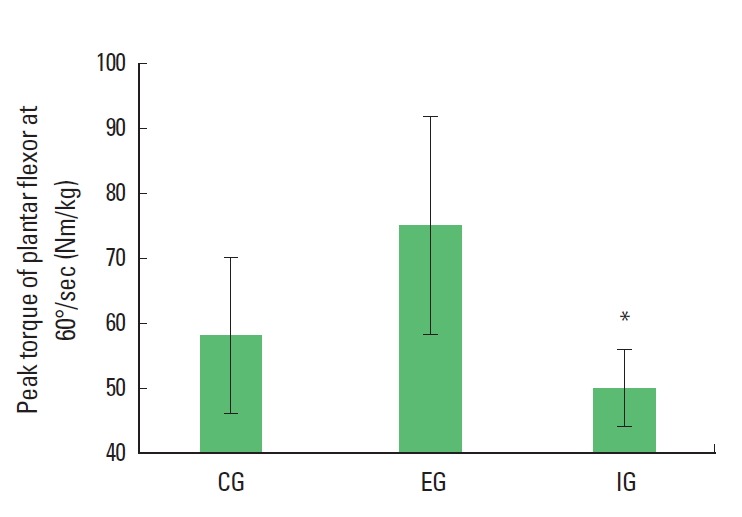
Difference of the flexor power of the plantar side at an angular velocity of 60°/sec between groups. CG, control group; EG, exercise group; and IG, injured group; *P< 0.05 vs EG.
Table 2.
ANOVA analysis of the flexor power of the plantar side at an angular velocity of 60°/sec between groups
| Sum of squares | df | Mean square | F | Sig | |
|---|---|---|---|---|---|
| Between groups | 1,794.807 | 2 | 897.403 | 6.115 | 0.009 |
| Within groups | 2,641.420 | 18 | 146.746 | ||
| Total | 4,436.227 | 20 |
The flexor power of the plantar side at an angular velocity of 120°/sec
In the results of analysis of the differences between groups in the flexor power of the plantar side at an angular velocity of 120°/ sec, a significant difference was found in P level<0.001 between groups. Also, in the results of the post hoc test, CG of the 50.79 ±7.58 Nm/kg in flexor power of plantar was 26.31% significantly lower than EG of 68.91±8.366 Nm/kg in P level<0.01 and was 19.49% significantly lower than IG of 55.49±9.92 Nm/kg in P level<0.05 (Fig. 2 and Table 3).
Fig. 2.
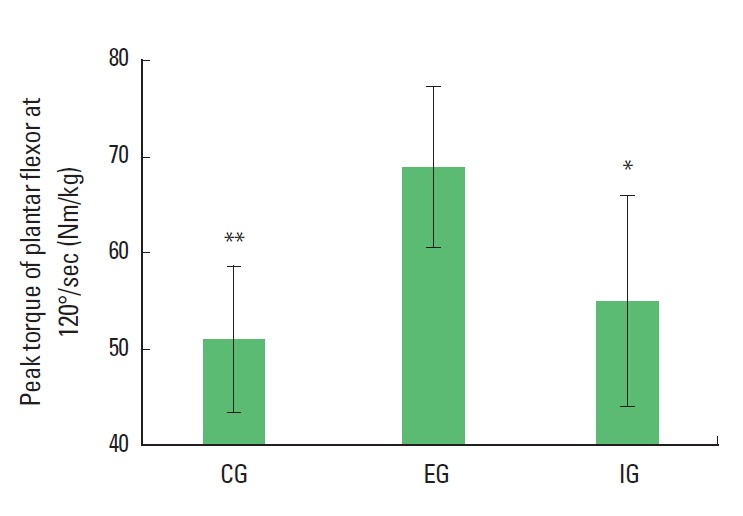
Difference of the flexor power of the plantar side at an angular velocity of 120°/sec between groups. CG, control group; EG, exercise group; and IG, injured group; *P< 0.05, **P< 0.01 vs EG.
Table 3.
ANOVA analysis of the flexor power of the plantar side at an angular velocity of 120°/sec between groups
| Sum of squares | df | Mean square | F | Sig | |
|---|---|---|---|---|---|
| Between groups | 1,239.114 | 2 | 619.572 | 8.235 | 0.003 |
| Within groups | 1,354.266 | 18 | 75.237 | ||
| Total | 2,393.410 | 20 |
Flexor power of the dorsal side
Flexor power of the dorsal side at an angular velocity of 60°/sec
We found no statistically significant differences in the results of analysis of the flexor of the dorsal side between groups at an angular velocity of 60°/sec as shown in Fig. 3 and Table 4.
Fig. 3.
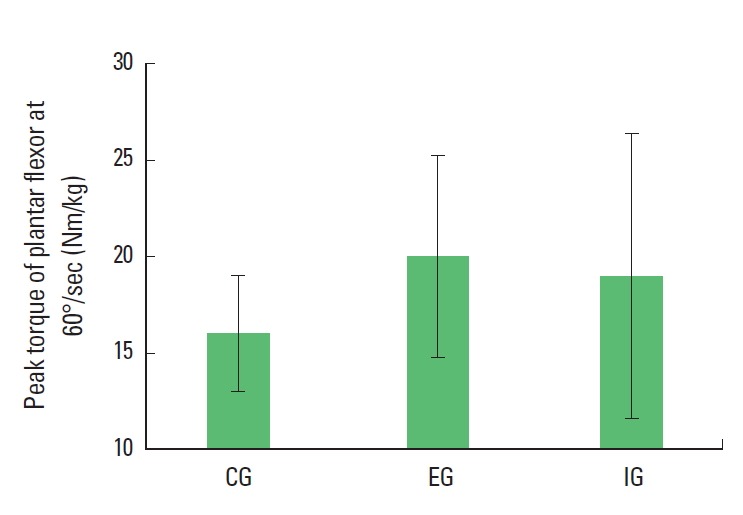
Difference of the flexor power of dorsal side at an angular velocity of 60°/sec between groups. CG, control group; EG, exercise group; and IG, injured group.
Table 4.
ANOVA analysis of the flexor power of the dorsal side at an angular velocity of 60°/sec
| Sum of squares | df | Mean square | F | Sig | |
|---|---|---|---|---|---|
| Between groups | 48.441 | 2 | 24.220 | 0.859 | 0.440 |
| Within groups | 507.617 | 18 | 28.201 | ||
| Total | 556.058 | 20 |
The flexor power of the plantar side at an angular velocity of 120°/sec
We found no statistically significant differences in the results of the analysis of the flexor of the dorsal side between groups at an angular velocity of 120°/sec as shown in Fig. 4 and Table 5.
Fig. 4.
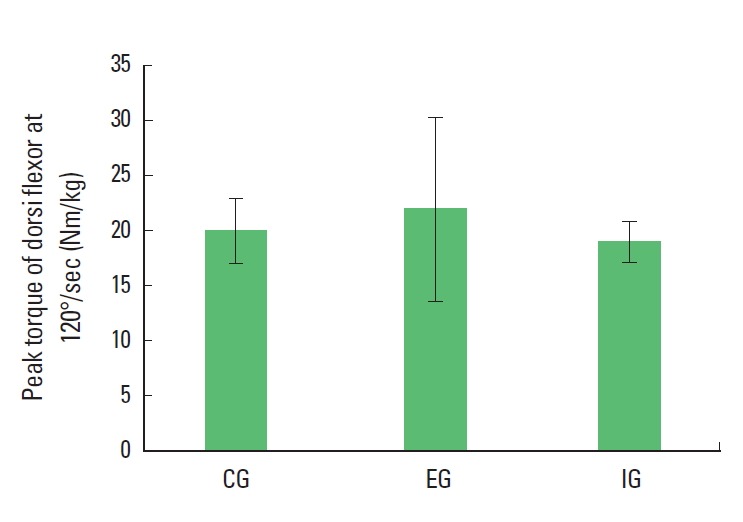
Difference of the flexor power of dorsal side at an angular velocity of 120°/sec between groups. CG, control group; EG, exercise group; and IG, injured group.
Table 5.
ANOVA analysis of the flexor power of the dorsal side at an angular velocity of 120°/sec between groups
| Sum of squares | df | Mean square | F | Sig | |
|---|---|---|---|---|---|
| Between groups | 38.030 | 2 | 19.015 | 0.628 | 0.545 |
| Within groups | 545.380 | 18 | 30.299 | ||
| Total | 583.410 | 20 |
Muscle strength in valgus
Muscle strength in valgus at an angular velocity of 60°/sec
In the results of the analysis of the differences between groups in the muscle strength in valgus at an angular velocity of 60°/sec, a significant difference was found in P level<0.01 between groups. Also, in the results of the post hoc test, EG of the 24.74±5.79 Nm/kg in the muscle strength in valgus was 30.66% significantly higher than IG of 17.97±4.51 Nm/kg in P level<0.05 and was 27.37% significantly higher than IG of 17.16±1.79 Nm/kg in P level<0.05 (Fig. 5 and Table 6).
Fig. 5.
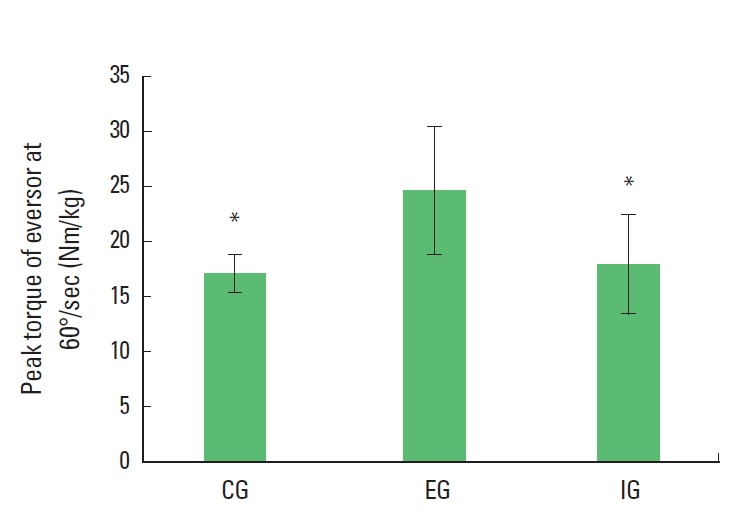
Differences in the muscle strength in valgus at an angular velocity of 60°/sec between groups. CG, control group; EG, exercise group; and IG, injured group; *P< 0.05 vs EG.
Table 6.
ANOVA analysis in the muscle strength in valgus at an angular velocity of 60°/sec between groups
| Sum of squares | df | Mean square | F | Sig | |
|---|---|---|---|---|---|
| Between groups | 242.803 | 2.000 | 121.401 | 6.386 | 0.008 |
| Within groups | 342.209 | 18.000 | 19.012 | ||
| Total | 585.011 | 20.000 |
Muscle strength in valgus at an angular velocity of 120°/sec
In the results of analysis of the differences between groups in the muscle strength in valgus at an angular velocity of 120°/sec, a significant difference was found in P level<0.001 between groups. And in the results of the post hoc test, EG of the 25.09±4.43 Nm/kg in the muscle strength in valgus was 70.82% significantly higher than IG of 14.69±4.27 Nm/kg in P level<0.001 and was 34.05% significantly higher than IG of 34.05 Nm/kg in P level<0.05 (Fig. 6 and Table 7).
Fig. 6.

Differences in the muscle strength in valgus at an angular velocity of 120°/sec between groups. CG, control group; EG, exercise group; and IG, injured group; *P< 0.05, ***P< 0.001 vs EG.
Table 7.
ANOVA analysis in the muscle strength in valgus at an angular velocity of 120°/sec between groups
| Sum of squares | df | Mean square | F | Sig | |
|---|---|---|---|---|---|
| Between groups | 384.964 | 2 | 192.482 | 13.933 | 0.000 |
| Within groups | 248.666 | 18 | 13.815 | ||
| Total | 633.630 | 20 |
Muscle strength in varus
Muscle strength in varus at an angular velocity of 60°/sec
We found no statistically significant difference in the results of analysis of the muscle strength in varus between groups at an angular velocity of 60°/sec as shown in Fig. 7 and Table 8.
Fig. 7.
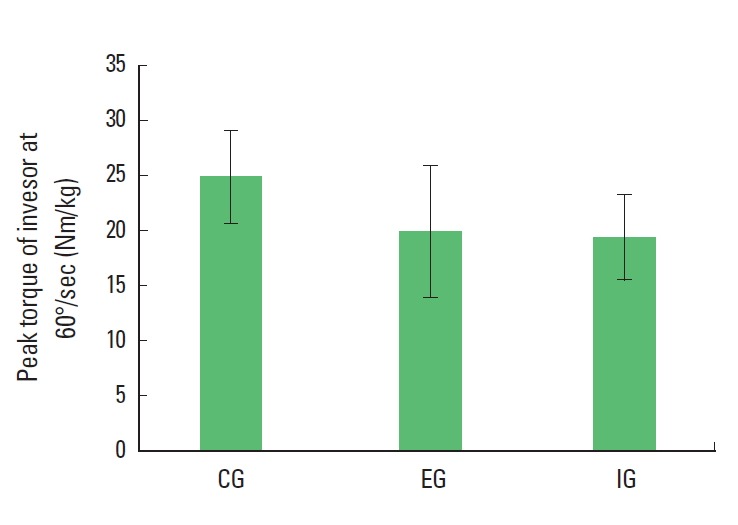
Differences in the muscle strength in varus at an angular velocity of 60°/sec between groups. CG, control group; EG, exercise group; and IG, injured group.
Table 8.
ANOVA analysis in the muscle strength in varus at an angular velocity of 60°/sec between groups
| Sum of squares | df | Mean square | F | Sig | |
|---|---|---|---|---|---|
| Between groups | 77.401 | 2 | 38.700 | 1.691 | 0.212 |
| Within groups | 411.969 | 18 | 22.887 | ||
| Total | 489.370 | 20 |
Muscle strength in varus at an angular velocity of 120°/sec
We found no statistically significant differences in the results of analysis of the muscle strength in varus between groups at an angular velocity of 120°/sec as shown in Fig. 8 and Table 9.
Fig. 8.
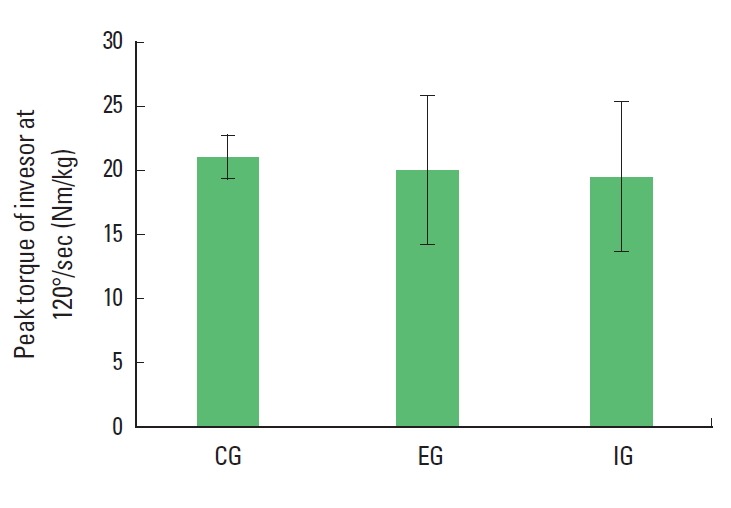
Differences in the muscle strength in varus at an angular velocity of 120°/sec between groups. CG, control group; EG, exercise group; and IG, injured group.
Table 9.
ANOVA analysis in the muscle strength in varus at an angular velocity of 120°/sec between groups
| Sum of squares | df | Mean square | F | Sig | |
|---|---|---|---|---|---|
| Between groups | 3.307 | 2.000 | 1.653 | 0.062 | 0.940 |
| Within groups | 476.386 | 18.000 | 26.466 | ||
| Total | 479.692 | 20.000 |
Proprioceptive sense
In the results of the analysis of the differences between groups in the proprioceptive sense, a significant difference was found in P level<0.05. And in the results of the post hoc test, EG of the 2.90±0.54° was 33.44% significantly lower than IG of 4.36±1.53° in P level<0.05 (Fig. 9 and Table 10).
Fig. 9.
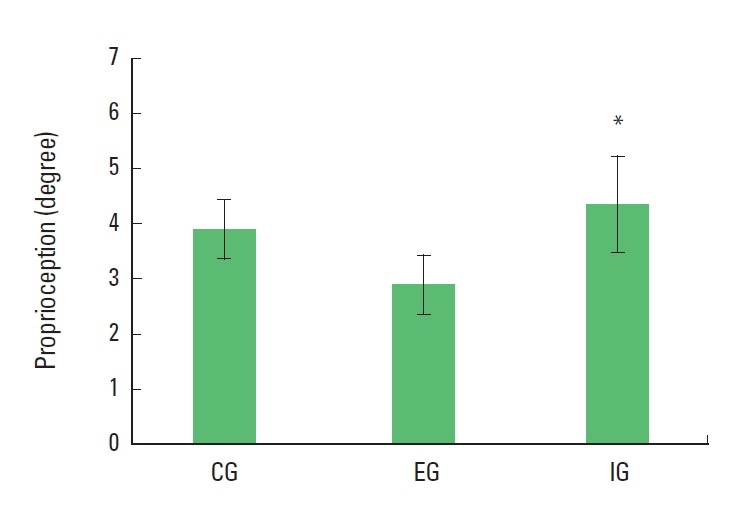
Differences of proprioceptive sense between groups. CG, control group; EG, exercise group; and IG, injured group; *P< 0.05 vs EG.
Table 10.
ANOVA analysis of the proprioceptive sense between groups
| Sum of squares | df | Mean square | F | Sig | |
|---|---|---|---|---|---|
| Between groups | 7.707 | 2 | 3.853 | 3.864 | 0.040 |
| Within groups | 17.951 | 18 | 0.997 | ||
| Total | 25.658 | 20 |
DISCUSSION
In the results of the analysis of the differences of the flexor power of the plantar and dorsal sides between an ordinary person and athletes of the modern pentathlon, athletes of the modern pentathlon were significantly higher than general college students for the flexor power of the plantar side at an angular velocity of 120°/sec. Athletes of the modern pentathlon were also higher than general college students for the flexor power of the plantar side at an angular velocity 60°/sec but it had no statistical significance.
In addition, athletes of the modern pentathlon were higher than general college students for the flexor power of the dorsal side at all angular velocities but it had no statistical significance. These results are similar to the results that the irritation of the surrounding muscles of the ankle had caused an increase in the flexor power of the plantar and dorsal sides as reported by Simoneau et al. (2006) and it is considered that it results from the characteristics of the modern pentathlon where there are heavy simulations on the ankle from fencing or running for the advancement of the body.
Related to this, in this study, the exercise group showed a considerably high level compared to the general group for the extroversion muscular strength and this is considered to be the adaptive effect of the defensive mechanism for introversion injury because modern pentathlon athletes have more frequent stress to their ankle from exercise and the strength is higher compared to normal people. Also, for the extroversion muscular strength of the injury group, it showed a considerable decrease compared to the exercise group and a similar level to the general group. This result is considered to have resulted in the repeated ankle injury weakening on the function of the extroversion muscular strength as reported by van Cingel et al. (2006). Opposite to this, for introversion muscular strength, it is considered to have resulted from the low contribution level of the introversion muscular strength for the relative extroversion injury suppression because of the anatomical stability of the ankle ligament mentioned earlier. This result is contrary to the Bressel and McNair (2001) report, studying the instability of the ankle affecting the functional change for gymnasts and the difference of their results to the result of this study is because of the difference in the study subject. For gymnasts, the ankle is required to be mobilized in various directions but for modern pentathlon athletes, the ankle is mobilized in a single direction only for track and field and fencing and it is considered that for modern pentathlon athletes, the characteristics according to the event can be examined as such in this study result. Among the kinetic change of the ankle on ankle injury, one of the generally accepted is the proprioceptive sense (Refshauge et al., 2000). Therefore, to measure this, various methods are introduced, such as standing in one foot with eyes closed or measurement of the body shake when standing in one foot (Isakov and Mizrahi, 1997: Perrin et al., 1997). But to measure the individual proprioceptive sense of the ankle from ankle injury, neurological control must be enabled and the method of suppressing the effect of the central nervous system is required. Therefore, in this study, to exclude visual effect, parts above the calves were fixed to be executed (Willems et al., 2002). Also, according to the report of Gross (1987), there were no difference in the proprioceptive sense of the affected side and constraint side on extroversion and introversion for 14 patients with ankle strain. It is then considered that the change of ankle proprioceptive sense is limited to flexion of the plantar and the dorsal side. As an analysis result of the proprioceptive sense, there were no statistical similarity of the exercise group compared to the general group but not only did it show a higher level of tendency because for the injury group and a similar lowness in the level compared to the exercise group but it also showed low level tendency compared to the general group. These results are similar to many other reported studies and showed to be considered as the important cause of prolonging and increasing the risk of reinjury after ankle injury (Hertel, 2000: Holme et al., 1999; Nilsson et al., 2006). Therefore, not only for the rehabilitation process of these injuries but also for the prevention of ankle injuries, it is considered that an effort is required to increase the ability of proprioception of the ankle.
After measuring the muscular strength on the peripheral ankle and proprioceptive sensation function of the general university students and the modern pentathlon athletes with ankle injury experience, the following result was acquired.
For the plantar side of the hamstring muscular strength, in an angular velocity of 60°/sec, the exercise group showed a considerable increase compared to the injury group and in angular velocity of 120°/sec, the general group showed a considerable increase compared to the injury group.
For the dorsal side of the hamstring muscular strength, there was no considerable difference between the groups found.
For extroversion muscular strength, in an angular velocity of 60°/sec, the exercise group showed an overall considerable increase compared to the injury group and the general group and in an angular velocity of 120°/sec, the general group showed a considerable increase compared to the injury group.
For introversion muscular strength, there was no considerable difference between groups found.
For proprioceptive sensation function, the exercise group showed a considerably higher level than the injury group.
In conclusion, long-term participation to modern pentathlon sports resulted in an increase in plantar hamstring muscular strength and extroversion muscular strength on the ankle compared to general university students and the exercise injury of the ankle resulted in weakening plantar hamstring muscular strength and extroversion muscular strength and degradation of proprioceptive sensation.
Footnotes
CONFLICT OF INTEREST
No potential conflict of interest relevant to this article was reported.
REFERENCES
- Beumer A, Valstar ER, Garling EH, Niesing R, Heijboer RP, Ranstam J, Swierstra BA. Kinematics before and after reconstruction of the syndesmosis of the ankle: a prospective radiostereometric and clinical study in 5 patients. 2005;76(5):713–720. doi: 10.1080/17453670510041817. [DOI] [PubMed] [Google Scholar]
- Bishop GW, Fallon KE. Musculoskeletal injuries in a six-day track race ultramarathoner’s ankle. Clin J Sport Med. 1999;9(4):216–220. doi: 10.1097/00042752-199910000-00006. [DOI] [PubMed] [Google Scholar]
- Borland ML, Rogers IR. Injury and illness in a wilderness multisport endurance event. Wilderness Environ Med. 1997;8(2):82–88. doi: 10.1580/1080-6032(1997)008[0082:iaiiaw]2.3.co;2. [DOI] [PubMed] [Google Scholar]
- Bressel E, McNair PJ. Biomechanical behavior of the plantar flexor muscle-tendon unit after an achilles tendon rupture. Am J Sports Med. 2001;29(3):321–326. doi: 10.1177/03635465010290031201. [DOI] [PubMed] [Google Scholar]
- Geraci MC, Jr, Brown W. Evidence-based treatment of hip and pelvic injuries in runners. Phys Med Rehabil Clin N Am. 2005;16(3):711–747. doi: 10.1016/j.pmr.2005.02.004. [DOI] [PubMed] [Google Scholar]
- Gross MT. Effects of recurrent lateral ankle sprains on active and passive judgments of joint position. Phys Ther. 1987;67:1505–1509. doi: 10.1093/ptj/67.10.1505. [DOI] [PubMed] [Google Scholar]
- Halasi T, Kynsburg A, Tallay A, Berkes I. Changer in joint position sense after surgically treated chronic lateral ankle instability. Br J Sports Med. 2005;39(11):818–824. doi: 10.1136/bjsm.2004.016527. [DOI] [PMC free article] [PubMed] [Google Scholar]
- Hertel J. Functional instability following lateral ankle sprain. Sports Med. 2000;29:361–371. doi: 10.2165/00007256-200029050-00005. [DOI] [PubMed] [Google Scholar]
- Holme E, Magnusson SP, Becker K, Bieler T, Aagaard P, Kjaer M. The effect of supervised rehabilitation on strength, postural sway, position sense and re-injury risk after ankle ligament sprain. Scand J Med Sci Sports. 1999:104–109. doi: 10.1111/j.1600-0838.1999.tb00217.x. [DOI] [PubMed] [Google Scholar]
- Hrysomallis C, McLaughlin P, Goodman C. Does a balance deficit persist in Australian football players with previous lower limb ligament injury. J Sci Med Sport. 2005;8(1):85–91. doi: 10.1016/s1440-2440(05)80028-3. [DOI] [PubMed] [Google Scholar]
- Hubbard TJ, Hertel J, Sherbondy P. Fibular position in individuals with self-reported chronic ankle instability. J Orthop Sports Phys Ther. 2006;36(1):3–9. doi: 10.2519/jospt.2006.36.1.3. [DOI] [PubMed] [Google Scholar]
- Hufner TM, Brandes DB, Thermann H, Richter M, Knobloch K, Krettek C. Long-term results after functional nonoperative treatment of achilles tendon rupture. Foot Ankle Int. 2006;27(3):167–171. doi: 10.1177/107110070602700302. [DOI] [PubMed] [Google Scholar]
- Isakov E, Mizrahi J. Is balance impaired by recurrent sprained ankle? Br J Sports Med. 1997;31:6–67. doi: 10.1136/bjsm.31.1.65. [DOI] [PMC free article] [PubMed] [Google Scholar]
- Kaminski TW, Buckley BD, Powers ME, Hubbard TJ, Ortiz C. Effect of strength and proprioception training on eversion to inversion strength ratios in subjects with unilateral functional ankle instability. Br J Sports Med. 2003;37(5):410–415. doi: 10.1136/bjsm.37.5.410. [DOI] [PMC free article] [PubMed] [Google Scholar]
- Klement A, Sandholzer H, Frenzen A. Sports and leisure injuries in summer. MMW FortschrMed. 2005;147(26):26–29. [PubMed] [Google Scholar]
- Lephart SM, Pincivero DM, Giraldo JL, Fu FH. The role of proprioception in the management and rehabilitation of athletic injuries. Am J Sports Med. 1997;25(1):130–137. doi: 10.1177/036354659702500126. [DOI] [PubMed] [Google Scholar]
- Nilsson G, Ageberg E, Ekdahl C, Eneroth M. Balance in single-limb stance after surgically treated ankle fractures: a 14-month follow-up. BMC Musculoskelet Disord. 2006;5(7):35. doi: 10.1186/1471-2474-7-35. [DOI] [PMC free article] [PubMed] [Google Scholar]
- Perrin PP, Béné MC, Perrin CA, Durupt D. Ankle trauma significantly impairs posture control: a study in basketball players and controls. Int J Sports Med. 1997;18:387–392. doi: 10.1055/s-2007-972651. [DOI] [PubMed] [Google Scholar]
- Lephart SM, Pincivero DM, Rozzi SL. Proprioception of the ankle and knee. Sports Medicion. 1998;25:149–155. doi: 10.2165/00007256-199825030-00002. [DOI] [PubMed] [Google Scholar]
- Refshauge KM, Kilbreath SL, Raymond J. The effect of recurrent ankle inversion sprain and taping on proprioception at the ankle. Med Sci Sports Exerc. 2000;32:10–15. doi: 10.1097/00005768-200001000-00003. [DOI] [PubMed] [Google Scholar]
- Ross SE, Guskiewicz KM, Yu B. Single-leg jump-landing stabilization times in subjects with functionally unstable ankles. J Athl Train. 2005;40(4):298–304. [PMC free article] [PubMed] [Google Scholar]
- Self BP, Harris S, Greenwald RM. Ankle biomechanics during impact landings on uneven surfaces. Foot Ankle Int. 2000;21(2):138–144. doi: 10.1177/107110070002100208. [DOI] [PubMed] [Google Scholar]
- Simoneau E, Martin A, Porter MM, Van Hoecke J. Strength training in old age: adaptation of antagonist muscles at the ankle joint. Muscle Nerve. 2006;33(4):546–555. doi: 10.1002/mus.20492. [DOI] [PubMed] [Google Scholar]
- Tyler TF, McHugh MP, Mirabella MR, Mullaney MJ, Nicholas SJ. Risk factors for noncontact ankle sprains in high school football players: the role of previous ankle sprains and body mass index. Am J Sports Med. 2006;34(3):471–475. doi: 10.1177/0363546505280429. [DOI] [PubMed] [Google Scholar]
- van Cingel RE, Kleinrensink G, Uitterlinden EJ, Rooijens PP, Mulder PG, Aufdemkampe G, Stoeckart R. Repeated ankle sprains and delayed neuromuscular response: acceleration time parameters. J Orthop Sports Phys Ther. 2006;36(2):72–79. doi: 10.2519/jospt.2006.36.2.72. [DOI] [PubMed] [Google Scholar]
- Willems T, Witvrouw E, Verstuyft J, Vaes P, De Clercq D. Proprioception and muscle strength in subjects with a history of ankle sprains and chronic instability. J Athl Train. 2002;37(4):487–493. [PMC free article] [PubMed] [Google Scholar]
- Xu D, Hong Y, Li J, Chan K. Effect of tai chi exercise on proprioception of ankle and knee joints in old people. Br J Sports Med. 2004;38(1):50–54. doi: 10.1136/bjsm.2002.003335. [DOI] [PMC free article] [PubMed] [Google Scholar]


